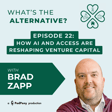
What's the Alternative? | Episode 9 | Interval Funds: The Good, The Bad & The Ugly featuring Kimberly Flynn
Welcome to Banrion Capital Management’s What’s the Alternative Podcast! Join host Shana Orczyk Sissel, the “Queen of Alternatives” Founder & CEO of Banrion Capital Management, as she interviews leaders in the alternative investment space. Learn more about their firms, their passions and about the many different ways investors can use alternative investments to add value in their investment portfolios.
In this episode Shana sits down with Kimberly Flynn, President of XA Investments to discuss everything you need to know about interval funds and their close cousin; tender offer funds.
As president of XA Investments, Kimberly, is a partner in the firm and responsible for all product and business development activities. Kim is responsible for the firm's proprietary fund platform and consulting practice.
Kim was a member of the founding leadership team for XAI, helping launch the firm in 2016 as Managing Director where she built XAI’s proprietary closed-end fund platform. In 2020, Ms. Flynn introduced the firm’s consulting practice to assist clients with developing US and UK registered closed-end funds.
Kim has more than 20 years of experience in investment product strategy, design and development. Prior to joining XAI, she led Nuveen Investment’s Global Structured Products Group which was responsible for the listed closed-end fund business. Her experience includes roles in registered fund product development for both traditional and alternative investment strategies.
Kim has developed an expertise in closed-end fund product development and is a frequent contributor to media and industry events on topics including interval funds, alternative investments and London-listed investment companies. Kim has earned the CFA designation and is a member of the CFA Institute and CFA Society Chicago. She is also Series 7, 63 and 24 licensed.
Learn More About XA Investments: XA Investments
Connect with Kim on LinkedIn: Kimberly Flynn
Learn More About Banrion: Banrion Capital Management
Connect with Banrion on 𝕏: @Banrion_Capital
Connect with Shana on LinkedIn: Shana Orczyk Sissel
Connect with Shana on 𝕏: @shanas621
If you are an advisor wanting to check out our platform, we want to hear your feedback!
Important Disclosures:
The opinions expressed on the “What’s the Alternative Podcast” are for general informational purposes only and are not intended to provide specific advice or recommendations for any individual or on any specific security.
It is only intended to provide education about the financial industry. To determine which investments may be appropriate for you, consult your financial advisor prior to investing. Any past performance discussed during this program is no guarantee of future results.
The guests featured on this program are participants on Banrion Capital Management’s platform. As such Banrion may receive payment for their participation as a platform partner.
Any indices referenced for comparison are unmanaged and cannot be invested into directly. As always please remember investing involves risk and possible loss of principal capital; please seek advice from a licensed professional.
Investments are not FDIC-insured, nor are they deposits of or guaranteed by a bank or any other entity, so they may lose value.</



















